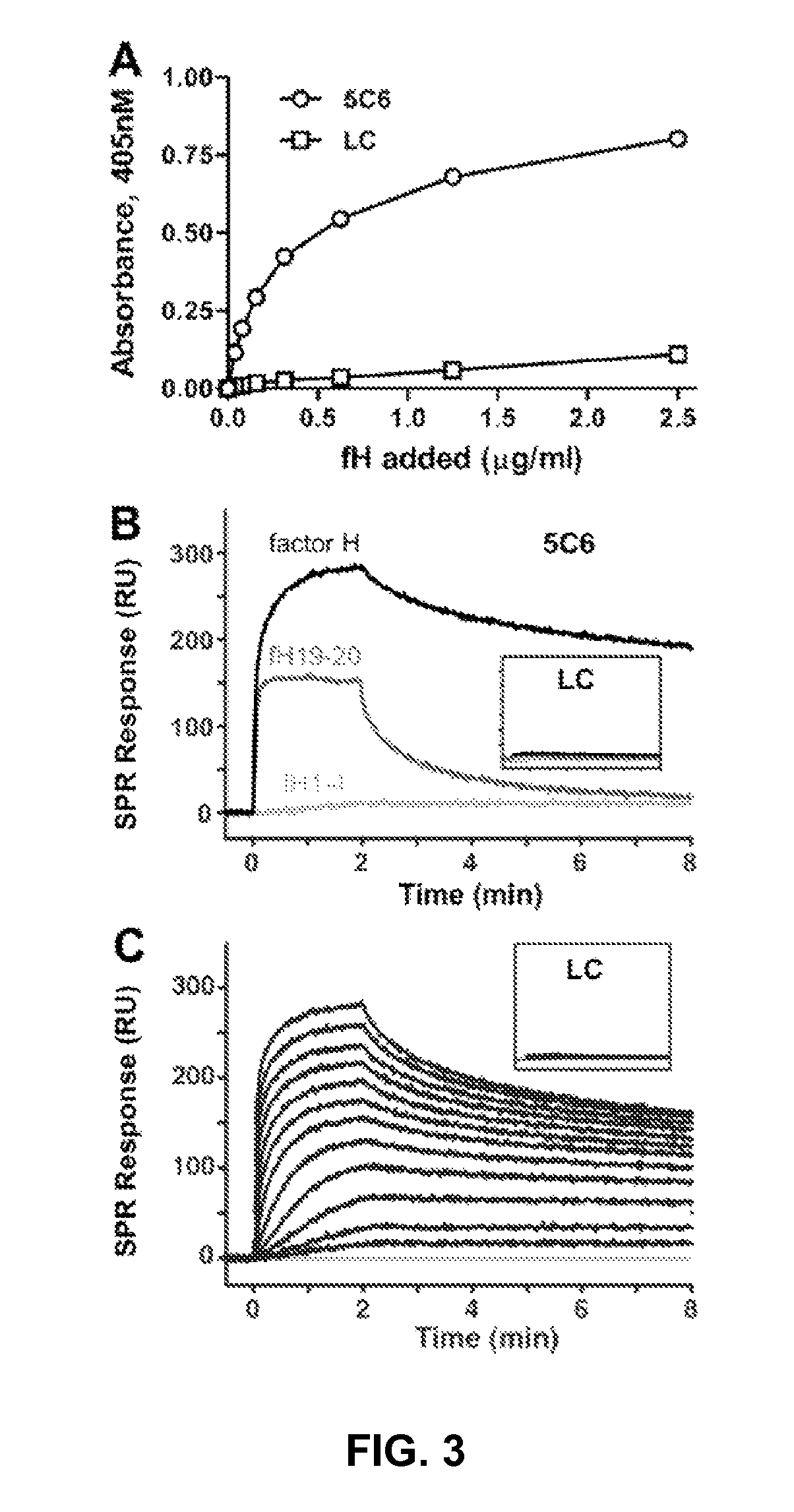Factor H binding peptides and uses thereof
a technology of peptides and peptides, applied in the field of inhibitors of complement activation, can solve the problems of inability to continuously administer soluble inhibitors, affecting the use of medical applications, and affecting the safety of patients, so as to reduce the activation of complement in the exposed biological substan
- Summary
- Abstract
- Description
- Claims
- Application Information
AI Technical Summary
Benefits of technology
Problems solved by technology
Method used
Image
Examples
example 1
[0069]This example describes the identification factor H binding peptides that bind factor H without compromising the complement-inhibitory and cell-binding activities of factor H.
[0070]Materials and Methods:
[0071]Complement Components and Recombinant Proteins.
[0072]Human factor H was purified from normal human serum (NHS) by 5-12% PEG precipitation. The pellet was resuspended in 3 mM KH2PO4, 50 mM NaCl, pH 7.4, and the sample was injected onto a Source Q column (GE Healthcare). The protein was eluted using a step gradient with increasing salt concentrations. Fractions containing factor H were identified by direct ELISA using rabbit anti-human factor H polyclonal antibody (raised by standard procedures) followed by HRP-conjugated goat anti-rabbit IgG (Bio-Rad), pooled, dialyzed and subsequently injected onto a Mono-S column (GE Healthcare). The eluted samples were identified by SDS-PAGE analysis, pooled and dialyzed against PBS, pH 7.4. Human complement C3 was purified from NHS acco...
example 2
[0083]This example sets forth a demonstration that certain of the peptides identified as described in Example 1 are capable of binding factor H without compromising the complement-inhibitory and cell-binding activities of factor H, and can be immobilized onto biomaterials.
[0084]Materials and Methods:
[0085]Peptide Synthesis.
[0086]Nα-Fmoc-amino acids, PyBOP and Rink amide MBHA resin (0.34 mmol / g) were obtained from Novabiochem (San Diego, Calif.). DIC was purchased from AnaSpec (San Jose, Calif.). HOAt was purchased from Advanced ChemTech (Louisville, Ky.). HSW syringes (Torviq, Niles, Mich.) (10 ml) with frits on the bottom were used for all peptide syntheses. Dichloromethane (DCM) and N-methylpyrrolidinone were obtained from Fisher Scientific. All other chemical reagents for synthesis were purchased from Sigma-Aldrich (St Louis, Mo.) and used without further purification.
[0087]The N-terminal Fmoc protected linear peptides used in this study were synthesized on an Applied Biosystems ...
PUM
| Property | Measurement | Unit |
|---|---|---|
| pH | aaaaa | aaaaa |
| temperature | aaaaa | aaaaa |
| pH | aaaaa | aaaaa |
Abstract
Description
Claims
Application Information
 Login to View More
Login to View More - R&D
- Intellectual Property
- Life Sciences
- Materials
- Tech Scout
- Unparalleled Data Quality
- Higher Quality Content
- 60% Fewer Hallucinations
Browse by: Latest US Patents, China's latest patents, Technical Efficacy Thesaurus, Application Domain, Technology Topic, Popular Technical Reports.
© 2025 PatSnap. All rights reserved.Legal|Privacy policy|Modern Slavery Act Transparency Statement|Sitemap|About US| Contact US: help@patsnap.com



